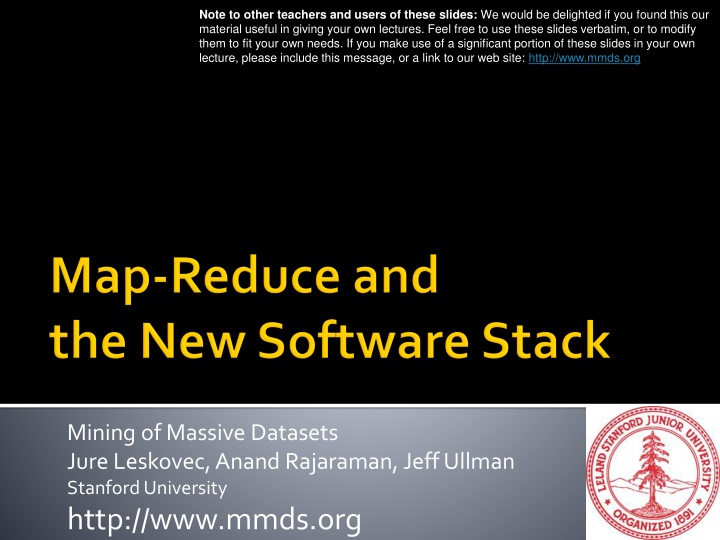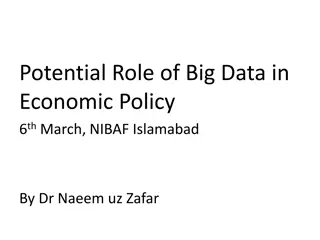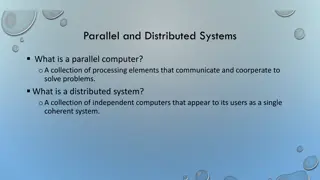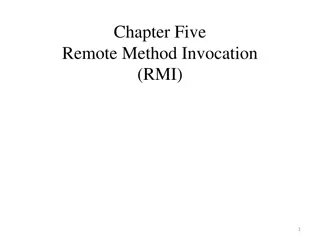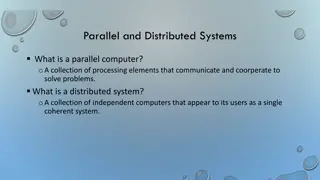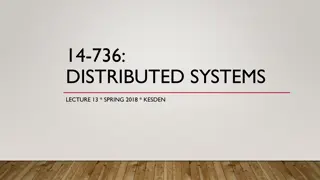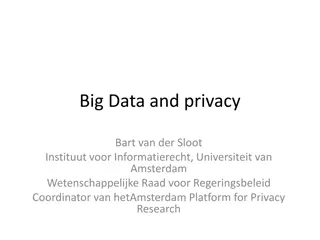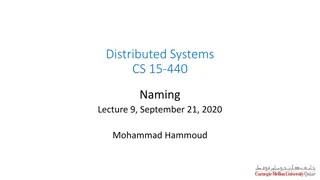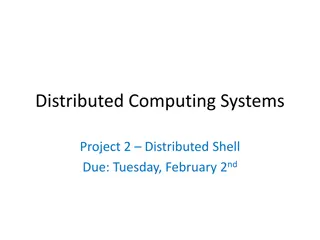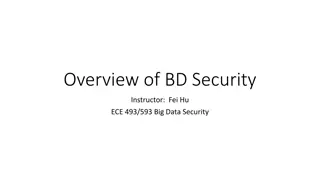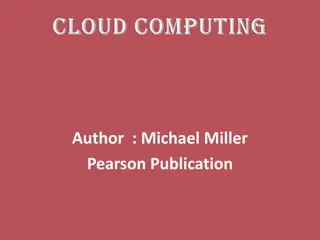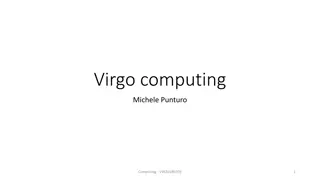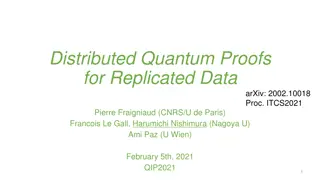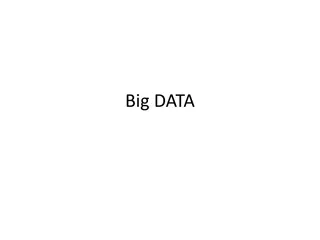Challenges in Distributed Computing for Big Data
Addressing the complexities of distributed/parallel programming, the utilization of Map-reduce to handle computation, and the emergence of commodity hardware clusters for efficient data processing in large-scale computing scenarios. The content emphasizes the significance of network architecture and the need for making distributed programming more accessible.
Download Presentation

Please find below an Image/Link to download the presentation.
The content on the website is provided AS IS for your information and personal use only. It may not be sold, licensed, or shared on other websites without obtaining consent from the author.If you encounter any issues during the download, it is possible that the publisher has removed the file from their server.
You are allowed to download the files provided on this website for personal or commercial use, subject to the condition that they are used lawfully. All files are the property of their respective owners.
The content on the website is provided AS IS for your information and personal use only. It may not be sold, licensed, or shared on other websites without obtaining consent from the author.
E N D
Presentation Transcript
Note to other teachers and users of these slides: We would be delighted if you found this our material useful in giving your own lectures. Feel free to use these slides verbatim, or to modify them to fit your own needs. If you make use of a significant portion of these slides in your own lecture, please include this message, or a link to our web site: http://www.mmds.org Mining of Massive Datasets Jure Leskovec, Anand Rajaraman, Jeff Ullman Stanford University http://www.mmds.org
Challenges: How to distribute computation? Distributed/parallel programming is hard Map-reduce addresses all of the above Google s computational/data manipulation model Elegant way to work with big data J. Leskovec, A. Rajaraman, J. Ullman: Mining of Massive Datasets, http://www.mmds.org 2
CPU Machine Learning, Statistics Memory Classical Data Mining Disk J. Leskovec, A. Rajaraman, J. Ullman: Mining of Massive Datasets, http://www.mmds.org 3
20+ billion web pages x 20KB = 400+ TB 1 computer reads 30-35 MB/sec from disk ~4 months to read the web ~1,000 hard drives to store the web Takes even more to do something useful with the data! Today, a standard architecture for such problems is emerging: Cluster of commodity Linux nodes Commodity network (ethernet) to connect them J. Leskovec, A. Rajaraman, J. Ullman: Mining of Massive Datasets, http://www.mmds.org 4
2-10 Gbps backbone between racks 1 Gbps between any pair of nodes in a rack Switch Switch Switch CPU CPU CPU CPU Mem Mem Mem Mem Disk Disk Disk Disk Each rack contains 16-64 nodes In 2011 it was guestimated that Google had 1M machines, http://bit.ly/Shh0RO J. Leskovec, A. Rajaraman, J. Ullman: Mining of Massive Datasets, http://www.mmds.org 5
J. Leskovec, A. Rajaraman, J. Ullman: Mining of Massive Datasets, http://www.mmds.org 6
Large-scale computing for data mining problems on commodity hardware Challenges: Machines failures Network bottleneck How can we make it easy to write distributed programs? J. Leskovec, A. Rajaraman, J. Ullman: Mining of Massive Datasets, http://www.mmds.org 7
One server may stay up 3 years (1,000 days) If you have 1,000 servers, expect to lose 1/day People estimated Google had ~1M machines in 2011 1,000 machines fail every day! Solution: copy data J. Leskovec, A. Rajaraman, J. Ullman: Mining of Massive Datasets, http://www.mmds.org 8
Issue: Copying data over a network takes time Solution: Bring computation close to the data Store files multiple times for reliability J. Leskovec, A. Rajaraman, J. Ullman: Mining of Massive Datasets, http://www.mmds.org 9
Map-reduce addresses this problem Google s computational/data manipulation model Elegant way to work with big data Programming model Map-Reduce J. Leskovec, A. Rajaraman, J. Ullman: Mining of Massive Datasets, http://www.mmds.org 10
Distributed File System: Provides global file namespace Google GFS; Hadoop HDFS; Typical usage pattern Huge files (100s of GB to TB) Data is rarely updated in place Reads and appends are common J. Leskovec, A. Rajaraman, J. Ullman: Mining of Massive Datasets, http://www.mmds.org 11
Chunk servers File is split into contiguous chunks Typically each chunk is 16-64MB Each chunk replicated (usually 2x or 3x) Try to keep replicas in different racks Master node a.k.a. Name Node in Hadoop s HDFS Stores metadata about where files are stored Might be replicated Client library for file access Talks to master to find chunk servers Connects directly to chunk servers to access data J. Leskovec, A. Rajaraman, J. Ullman: Mining of Massive Datasets, http://www.mmds.org 12
Reliable distributed file system Data kept in chunks spread across machines Each chunk replicated on different machines Seamless recovery from disk or machine failure C1 C2 C0 D0 C1 C5 C0 C5 D1 D0 D0 C2 C5 C2 C3 C5 Chunk server 1 Chunk server 3 Chunk server N Chunk server 2 Bring computation directly to the data! Chunk servers also serve as compute servers J. Leskovec, A. Rajaraman, J. Ullman: Mining of Massive Datasets, http://www.mmds.org 13
Warm-up task: We have a huge text document Count the number of times each distinct word appears in the file Sample application: Analyze web server logs to find popular URLs J. Leskovec, A. Rajaraman, J. Ullman: Mining of Massive Datasets, http://www.mmds.org 14
Case 1: File too large for memory, but all <word, count> pairs fit in memory Case 2: Count occurrences of words: words(doc.txt) | sort | uniq -c where words takes a file and outputs the words in it, one per a line Case 2 captures the essence of MapReduce Great thing is that it is naturally parallelizable J. Leskovec, A. Rajaraman, J. Ullman: Mining of Massive Datasets, http://www.mmds.org 15
Sequentially read a lot of data Map: Scan input file record at a time Extract something you care about Group by key: Sort and Shuffle Reduce: Aggregate, summarize, filter or transform Write the result Outline stays the same, Map and Reduce change to fit the problem J. Leskovec, A. Rajaraman, J. Ullman: Mining of Massive Datasets, http://www.mmds.org 16
Input key-value pairs Intermediate key-value pairs k v map v k k v map v k k v v k v k J. Leskovec, A. Rajaraman, J. Ullman: Mining of Massive Datasets, http://www.mmds.org 17
Output key-value pairs Intermediate key-value pairs Key-value groups reduce k v k v v v k v reduce Group by key k v k v k v v k v k v k v k v J. Leskovec, A. Rajaraman, J. Ullman: Mining of Massive Datasets, http://www.mmds.org 18
Input: a set of key-value pairs Programmer specifies two methods: Map(k, v) <k , v >* Takes a key-value pair and outputs a set of key-value pairs E.g., key is the filename, value is a single line in the file There is one Map call for every (k,v) pair Reduce(k , <v >*) <k , v >* All values v with same key k are reduced together and processed in v order There is one Reduce function call per unique key k J. Leskovec, A. Rajaraman, J. Ullman: Mining of Massive Datasets, http://www.mmds.org 19
Provided by the programmer Provided by the programmer MAP: Reduce: Collect all values belonging to the key and output Group by key: Collect all pairs with same key Read input and produces a set of key-value pairs Sequentially read the data The crew of the space shuttle Endeavor recently returned to ambassadors, harbingers of a new era of space exploration. Scientists at NASA are saying that the recent assembly of the Dextre bot is the first step in a long-term space-based man/mache '"The work we're doing now -- the robotics we're doing - - is what we're going to need .. Only sequential reads (The, 1) (crew, 1) (of, 1) (the, 1) (space, 1) (shuttle, 1) (Endeavor, 1) (recently, 1) . (crew, 1) (crew, 1) (space, 1) (the, 1) (the, 1) (the, 1) (shuttle, 1) (recently, 1) Earth as (crew, 2) (space, 1) (the, 3) (shuttle, 1) (recently, 1) partnership. Big document (key, value) (key, value) (key, value) J. Leskovec, A. Rajaraman, J. Ullman: Mining of Massive Datasets, http://www.mmds.org 20
map(key, value): // key: document name; value: text of the document for each word w in value: emit(w, 1) reduce(key, values): // key: a word; value: an iterator over counts result = 0 for each count v in values: result += v emit(key, result) J. Leskovec, A. Rajaraman, J. Ullman: Mining of Massive Datasets, http://www.mmds.org 21
Map-Reduce environment takes care of: Partitioning the input data Scheduling the program s execution across a set of machines Performing the group by key step Handling machine failures Managing required inter-machine communication J. Leskovec, A. Rajaraman, J. Ullman: Mining of Massive Datasets, http://www.mmds.org 22
Big document MAP: Read input and produces a set of key-value pairs Group by key: Collect all pairs with same key (Hash merge, Shuffle, Sort, Partition) Reduce: Collect all values belonging to the key and output J. Leskovec, A. Rajaraman, J. Ullman: Mining of Massive Datasets, http://www.mmds.org 23
All phases are distributed with many tasks doing the work J. Leskovec, A. Rajaraman, J. Ullman: Mining of Massive Datasets, http://www.mmds.org 24
Programmer specifies: Map and Reduce and input files Workflow: Read inputs as a set of key-value- pairs Map transforms input kv-pairs into a new set of k'v'-pairs Sorts & Shuffles the k'v'-pairs to output nodes All k v -pairs with a given k are sent to the same reduce Reduce processes all k'v'-pairs grouped by key into new k''v''-pairs Write the resulting pairs to files Input 0 Input 1 Input 2 Map 0 Map 1 Map 2 Shuffle Reduce 0 Reduce 1 Out 1 Out 0 All phases are distributed with many tasks doing the work J. Leskovec, A. Rajaraman, J. Ullman: Mining of Massive Datasets, http://www.mmds.org 25
Map-Reduce environment takes care of: Partitioning the input data Scheduling the programmer s execution across a set of machines Perform the group-by key step Handling node failures Managing inter-machine communication J. Leskovec, A. Rajaraman, J. Ullman: Mining of Massive Datasets, http://www.mmds.org 26
Input and final output are stored on a distributed file system (FS): Scheduler tries to schedule map tasks close to physical storage location of input data Intermediate results are stored on local FS of Map and Reduce workers Output is often input to another MapReduce task J. Leskovec, A. Rajaraman, J. Ullman: Mining of Massive Datasets, http://www.mmds.org 27
Master node takes care of coordination: Task status: (idle, in-progress, completed) Idle tasks get scheduled as workers become available When a map task completes, it sends the master the location and sizes of its R intermediate files, one for each reducer Master pushes this info to reducers Master pings workers periodically to detect failures J. Leskovec, A. Rajaraman, J. Ullman: Mining of Massive Datasets, http://www.mmds.org 28
Map worker failure Map tasks completed or in-progress at worker are reset to idle Reduce workers are notified when task is rescheduled on another worker Reduce worker failure Only in-progress tasks are reset to idle (because the completed tasks results are stored in DFS) Reduce task is restarted Master failure MapReduce task is aborted and client is notified J. Leskovec, A. Rajaraman, J. Ullman: Mining of Massive Datasets, http://www.mmds.org 29
M map tasks, R reduce tasks Rule of a thumb: Make M much larger than the number of nodes in the cluster One DFS chunk per map is common Improves dynamic load balancing and speeds up recovery from worker failures Usually R is smaller than M Because output is spread across R files J. Leskovec, A. Rajaraman, J. Ullman: Mining of Massive Datasets, http://www.mmds.org 30
Often a Map task will produce many pairs of the form (k,v1), (k,v2), for the same key k E.g., popular words in the word count example Can save network time by pre-aggregating values in the mapper: combine(k, list(v1)) v2 Combiner is usually same as the reduce function Works only if reduce function is commutative and associative J. Leskovec, A. Rajaraman, J. Ullman: Mining of Massive Datasets, http://www.mmds.org 33
Back to our word counting example: Combiner combines the values of all keys of a single mapper (single machine): Much less data needs to be copied and shuffled! J. Leskovec, A. Rajaraman, J. Ullman: Mining of Massive Datasets, http://www.mmds.org 34
Combiner trick works only when the Reduce function is commutative and associative Works with sum Does not work with average or median J. Leskovec, A. Rajaraman, J. Ullman: Mining of Massive Datasets, http://www.mmds.org 35
Want to control how keys get partitioned Inputs to map tasks are created by contiguous splits of input file Reduce needs to ensure that records with the same intermediate key end up at the same worker System uses a default partition function: hash(key) mod R Sometimes useful to override the hash function: E.g., hash(hostname(URL)) mod R ensures URLs from a host end up in the same output file J. Leskovec, A. Rajaraman, J. Ullman: Mining of Massive Datasets, http://www.mmds.org 36
Suppose we have a large web corpus Look at the metadata file Lines of the form: (URL, size, date, ) For each host, find the total number of bytes That is, the sum of the page sizes for all URLs from that particular host Map For each record output (hostname(url), size) Reduce Sum the sizes for each host J. Leskovec, A. Rajaraman, J. Ullman: Mining of Massive Datasets, http://www.mmds.org 38
Other examples: Link analysis and graph processing Machine Learning algorithms Statistical machine translation: Need to count number of times every 5-word sequence occurs in a large corpus of documents Very easy with MapReduce: Map: Extract (5-word sequence, count) from document Reduce: Combine the counts J. Leskovec, A. Rajaraman, J. Ullman: Mining of Massive Datasets, http://www.mmds.org 39
Compute the natural join R(A,B) S(B,C) R and S are each stored in files Tuples are pairs (a,b) or (b,c) A a1 a2 a3 a4 B b1 b1 b2 b3 B b2 b2 b3 C c1 c2 c3 A a3 a3 a4 C c1 c2 c3 = S R J. Leskovec, A. Rajaraman, J. Ullman: Mining of Massive Datasets, http://www.mmds.org 40
Use a hash function h from B-values to 1...k A Map process turns: Each input tuple R(a,b) into key-value pair (b,(a,R)) Each input tuple S(b,c) into (b,(c,S)) Map processes send each key-value pair with key b to Reduce process h(b) Hadoop does this automatically; just tell it what k is. Each Reduce process matches all the pairs (b,(a,R)) with all (b,(c,S)) and outputs (a,b,c). J. Leskovec, A. Rajaraman, J. Ullman: Mining of Massive Datasets, http://www.mmds.org 41
In MapReduce we quantify the cost of an algorithm using 1. Communication cost = total I/O of all processes 2. Elapsed communication cost = max of I/O along any path 3. (Elapsed) computation cost analogous, but count only running time of processes Note that here the big-O notation is not the most useful (adding more machines is always an option) J. Leskovec, A. Rajaraman, J. Ullman: Mining of Massive Datasets, http://www.mmds.org 42
For a map-reduce algorithm: Communication cost = input file size + 2 (sum of the sizes of all files passed from Map processes to Reduce processes) + the sum of the output sizes of the Reduce processes. Elapsed communication cost is the sum of the largest input + output for any map process, plus the same for any reduce process J. Leskovec, A. Rajaraman, J. Ullman: Mining of Massive Datasets, http://www.mmds.org 43
Either the I/O (communication) or processing (computation) cost dominates Ignore one or the other Total cost tells what you pay in rent from your friendly neighborhood cloud Elapsed cost is wall-clock time using parallelism J. Leskovec, A. Rajaraman, J. Ullman: Mining of Massive Datasets, http://www.mmds.org 44
Total communication cost = O(|R|+|S|+|R S|) Elapsed communication cost = O(s) We re going to pick k and the number of Map processes so that the I/O limit s is respected We put a limit s on the amount of input or output that any one process can have. s could be: What fits in main memory What fits on local disk With proper indexes, computation cost is linear in the input + output size So computation cost is like comm. cost J. Leskovec, A. Rajaraman, J. Ullman: Mining of Massive Datasets, http://www.mmds.org 45
Google Not available outside Google Hadoop An open-source implementation in Java Uses HDFS for stable storage Download: http://lucene.apache.org/hadoop/ Aster Data Cluster-optimized SQL Database that also implements MapReduce J. Leskovec, A. Rajaraman, J. Ullman: Mining of Massive Datasets, http://www.mmds.org 47
Ability to rent computing by the hour Additional services e.g., persistent storage Amazon s Elastic Compute Cloud (EC2) Aster Data and Hadoop can both be run on EC2 For CS341 (offered next quarter) Amazon will provide free access for the class J. Leskovec, A. Rajaraman, J. Ullman: Mining of Massive Datasets, http://www.mmds.org 48
Jeffrey Dean and Sanjay Ghemawat: MapReduce: Simplified Data Processing on Large Clusters http://labs.google.com/papers/mapreduce.html Sanjay Ghemawat, Howard Gobioff, and Shun- Tak Leung: The Google File System http://labs.google.com/papers/gfs.html J. Leskovec, A. Rajaraman, J. Ullman: Mining of Massive Datasets, http://www.mmds.org 49
Hadoop Wiki Introduction http://wiki.apache.org/lucene-hadoop/ Getting Started http://wiki.apache.org/lucene- hadoop/GettingStartedWithHadoop Map/Reduce Overview http://wiki.apache.org/lucene-hadoop/HadoopMapReduce http://wiki.apache.org/lucene- hadoop/HadoopMapRedClasses Eclipse Environment http://wiki.apache.org/lucene-hadoop/EclipseEnvironment Javadoc http://lucene.apache.org/hadoop/docs/api/ J. Leskovec, A. Rajaraman, J. Ullman: Mining of Massive Datasets, http://www.mmds.org 50
Releases from Apache download mirrors http://www.apache.org/dyn/closer.cgi/lucene/had oop/ Nightly builds of source http://people.apache.org/dist/lucene/hadoop/nig htly/ Source code from subversion http://lucene.apache.org/hadoop/version_control .html J. Leskovec, A. Rajaraman, J. Ullman: Mining of Massive Datasets, http://www.mmds.org 51
Programming model inspired by functional language primitives Partitioning/shuffling similar to many large-scale sorting systems NOW-Sort ['97] Re-execution for fault tolerance BAD-FS ['04] and TACC ['97] Locality optimization has parallels with Active Disks/Diamond work Active Disks ['01], Diamond ['04] Backup tasks similar to Eager Scheduling in Charlotte system Charlotte ['96] Dynamic load balancing solves similar problem as River's distributed queues River ['99] J. Leskovec, A. Rajaraman, J. Ullman: Mining of Massive Datasets, http://www.mmds.org 52
